
Australopithecus is a genus of early hominins that existed in Africa during the Late Pliocene and Early Pleistocene. The genera Homo emerged within Australopithecus, as sister to e.g. Australipitecus sediba. Also the genera Paranthropus, and Kenyanthropus emerged within the Australopithecus. Australopithecus is a member of the subtribe Australopithecina, which also includes Ardipithecus, though the term "australopithecine" is sometimes used to refer only to members of Australopithecus. Species include A. garhi, A. africanus, A. sediba, A. afarensis, A. anamensis, A. bahrelghazali and A. deyiremeda. Debate exists as to whether some Australopithecus species should be reclassified into new genera, or if Paranthropus and Kenyanthropus are synonymous with Australopithecus, in part because of the taxonomic inconsistency.

Donald Carl Johanson is an American paleoanthropologist. He is known for discovering, with Yves Coppens and Maurice Taieb, the fossil of a female hominin australopithecine known as "Lucy" in the Afar Triangle region of Hadar, Ethiopia.

Australopithecus afarensis is an extinct species of australopithecine which lived from about 3.9–2.9 million years ago (mya) in the Pliocene of East Africa. The first fossils were discovered in the 1930s, but major fossil finds would not take place until the 1970s. From 1972 to 1977, the International Afar Research Expedition—led by anthropologists Maurice Taieb, Donald Johanson and Yves Coppens—unearthed several hundreds of hominin specimens in Hadar, Ethiopia, the most significant being the exceedingly well-preserved skeleton AL 288-1 ("Lucy") and the site AL 333. Beginning in 1974, Mary Leakey led an expedition into Laetoli, Tanzania, and notably recovered fossil trackways. In 1978, the species was first described, but this was followed by arguments for splitting the wealth of specimens into different species given the wide range of variation which had been attributed to sexual dimorphism. A. afarensis probably descended from A. anamensis and is hypothesised to have given rise to Homo, though the latter is debated.
Paleoanthropology or paleo-anthropology is a branch of paleontology and anthropology which seeks to understand the early development of anatomically modern humans, a process known as hominization, through the reconstruction of evolutionary kinship lines within the family Hominidae, working from biological evidence and cultural evidence.

Hadar is a paleontological site in Mille district, Administrative Zone 1 of the Afar Region, Ethiopia, 15 km upstream (west) of the A1 road's bridge across the Awash River.

Australopithecus anamensis is a hominin species that lived approximately between 4.2 and 3.8 million years ago and is the oldest known Australopithecus species, living during the Plio-Pleistocene era.

Australopithecus garhi is a species of australopithecine from the Bouri Formation in the Afar Region of Ethiopia 2.6–2.5 million years ago (mya) during the Early Pleistocene. The first remains were described in 1999 based on several skeletal elements uncovered in the three years preceding. A. garhi was originally considered to have been a direct ancestor to Homo and the human line, but is now thought to have been an offshoot. Like other australopithecines, A. garhi had a brain volume of 450 cc (27 cu in); a jaw which jutted out (prognathism); relatively large molars and premolars; adaptations for both walking on two legs (bipedalism) and grasping while climbing (arboreality); and it is possible that, though unclear if, males were larger than females. One individual, presumed female based on size, may have been 140 cm tall.
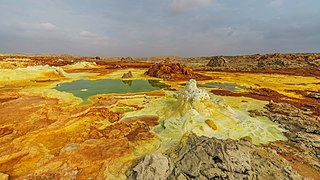
The Afar Region, formerly known as Region 2, is a regional state in northeastern Ethiopia and the homeland of the Afar people. Its capital is the planned city of Semera, which lies on the paved Awash–Assab highway.
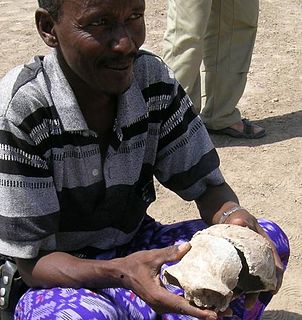
The Gawis cranium is a portion of a fossil hominin skull discovered on February 16, 2006 near the drainage of Gawis, a tributary of the Awash River in the Afar Depression, Ethiopia. Despite the presence of volcanic ash layers that are key to dating, the cranium is only generally dated between 200,000 and 500,000 years ago due to taphonomic issues.
Aramis is a village and archaeological site in north-eastern Ethiopia, where remains of Australopithecus and Ardipithecus have been found. The village is located in Administrative Zone 5 of the Afar Region, which is part of the Afar Sultanate of Dawe, with a latitude and longitude of 10°30′N40°30′E, and is part of the, Carri Rasuk, Xaale Faagê Daqaara.
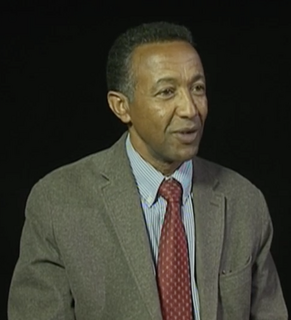
Yohannes Haile-SelassieAmbaye is an Ethiopian paleoanthropologist. An authority on pre-Homo sapiens hominids, he particularly focuses his attention on the East African Rift and Middle Awash valleys. He was curator of Physical Anthropology at the Cleveland Museum of Natural History from 2002 until 2021, and now is serving as the director of the Arizona State University Institute of Human Origins. Since founding the institute in 1981, he has been the third director after Donald Johanson and William Kimbel

AL 200-1 is the fossilized upper palate and teeth of the species Australopithecus afarensis, estimated to be 3.0-3.2 million years old. Its characteristics are an ape-like arrangement of teeth including spatulate incisors and a gap between the canines and outside incisors.

AL 129-1 is a fossilized knee joint of the species Australopithecus afarensis. It was discovered in Hadar, Ethiopia by Donald Johanson in November 1973.

AL 288-1, commonly known as Lucy, is a collection of several hundred pieces of fossilized bone representing 40 percent of a female of the hominin species Australopithecus afarensis. In Ethiopia, the assembly is also known as Dinkinesh, which means "you are marvelous" in Amharic. Lucy was discovered in 1974 in Africa, at Hadar, a site in the Awash Valley of the Afar Triangle in Ethiopia, by paleoanthropologist Donald Johanson of the Cleveland Museum of Natural History.
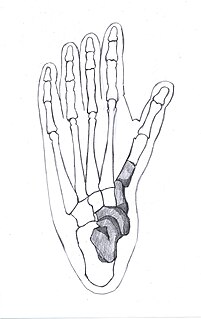
"Little Foot" is the nickname given to a nearly complete Australopithecus fossil skeleton found in 1994–1998 in the cave system of Sterkfontein, South Africa.
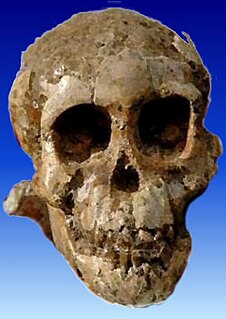
Selam (DIK-1/1) is the fossilized skull and other skeletal remains of a three-year-old Australopithecus afarensis female hominin, whose bones were first found in Dikika, Ethiopia in 2000 and recovered over the following years. Although she has often been nicknamed Lucy's baby, the specimen has been dated at 3.3 million years ago, approximately 120,000 years older than "Lucy".
The Dikika is an area of the Afar Region of Ethiopia where the hominin fossil named Selam was found. Dikika is located in Mille woreda.
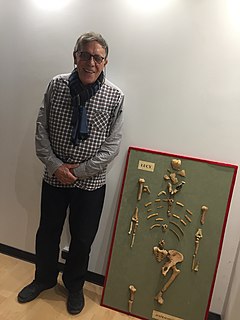
Maurice Taieb was a French geologist and paleoanthropologist. He discovered the Hadar formation, recognized its potential importance to paleoanthropology and founded the International Afar Research Expedition (IARE). This enabled co-director Donald Johanson to discover an early hominin fossil, the 3.2-million-year-old Australopithecine Lucy in the Awash Valley of Ethiopia's Afar Depression.

The Bouri Formation is a sequence of sedimentary deposits that is the source of australopithecine and Homo fossils, artifacts, and bones of large mammals with cut marks from butchery with tools by early hominins. It is located in the Middle Awash Valley, in Ethiopia, East Africa, and is a part of the Afar Depression that has provided rich human fossil sites such as Gona and Hadar.
The Middle Awash Project is an international research expedition conducted in the Afar region of Ethiopia with the goal of determining the origins of humanity. The project has the approval of the Ethiopian Culture Ministry and a strong commitment to developing Ethiopian archaeology, paleontology and geology research infrastructure. This project has discovered over 260 fossil specimens and over 17,000 vertebrate fossil specimens to date ranging from 200,000 to 6,000,000 years in age. Researchers have discovered the remains of four hominin species, the earliest subspecies of homo sapiens as well as stone tools. All specimens are permanently held at the National Museum of Ethiopia, where the project’s laboratory work is conducted year round.















